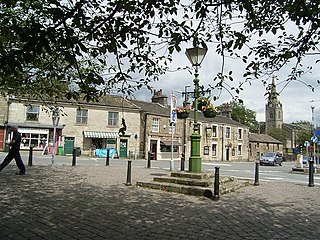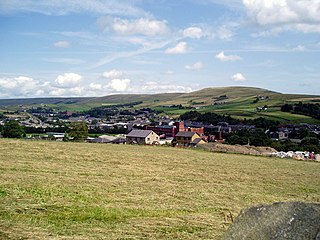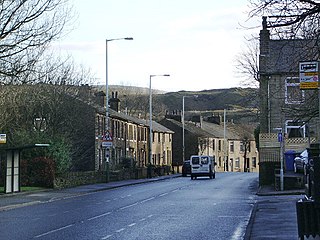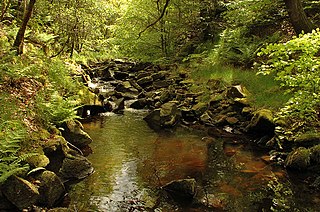
Bacup is a town in the Rossendale Borough in Lancashire, England, in the South Pennines close to Lancashire's boundaries with West Yorkshire and Greater Manchester. The town is in the Rossendale Valley and the upper Irwell Valley, 4 miles (6.4 km) east of Rawtenstall, 6 miles (9.7 km) north of Rochdale, and 7 miles (11 km) south of Burnley. At the 2011 Census, Bacup had a population of 13,323.

Rossendale is a local government district with borough status in Lancashire, England. Its council is based in Bacup and its largest town is Rawtenstall. It also includes the towns of Haslingden and Whitworth. The borough is named after the Rossendale Valley, the upper part of the River Irwell.

Rochdale is a town in Greater Manchester, England, and the administrative centre of the Metropolitan Borough of Rochdale. In the 2021 census the town had a population of 111,261, compared to 223,773 for the wider borough. Rochdale is in the foothills of the South Pennines and lies in the dale (valley) of the River Roch, 5 miles (8 km) northwest of Oldham, and 10 miles (16 km) northeast of Manchester.

Milnrow is a town within the Metropolitan Borough of Rochdale, in Greater Manchester, England. It lies on the River Beal at the foothills of the South Pennines, and forms a continuous urban area with Rochdale. It is 2 miles (3.2 km) east of Rochdale town centre, 10 miles (16.1 km) north-northeast of Manchester, and spans from Windy Hill in the east to the Rochdale Canal in the west. Milnrow is adjacent to junction 21 of the M62 motorway, and includes the village of Newhey, and hamlets at Tunshill and Ogden.

The River Roch is a river in Greater Manchester in North West England, a tributary of the River Irwell.

Littleborough is a town in the Metropolitan Borough of Rochdale, Greater Manchester, England, in the upper Roch Valley by the foothills of the South Pennines, 3 miles (4.8 km) northeast of Rochdale and 13 miles (20.9 km) northeast of Manchester; Milnrow and the M62 motorway are to the south, and the rural uplands of Blackstone Edge to the east. According to the 2001 census, Littleborough, and its suburbs of Calderbrook, Shore and Smithy Bridge, had a population of 13,807.

Rossendale and Darwen is a constituency in Lancashire represented in the House of Commons of the UK Parliament since 2010 by Jake Berry, the former Chairman of the Conservative Party.

Whitworth is a town and civil parish in Rossendale, Lancashire, England, amongst the foothills of the Pennines between Bacup, to the north, and Rochdale, to the south. It had a population of 7,500 at the 2011 Census.

Shawforth is a ward in the township of Whitworth within the Rossendale borough of Lancashire, England. It lies amongst the South Pennines along the course of the River Spodden and A671 road.

The River Calder is a major tributary of the River Ribble in Lancashire, England, and is around 20 miles (32 km) in length.

The River Roddlesworth is a river in Lancashire, England, a tributary of the River Darwen.

Shawclough is a mainly residential area north of Rochdale, Greater Manchester, England. Its boundaries are roughly Whitworth Road, Shawclough Road, and Healey Corner. Housing is mixed but predominantly owned semi-detached and detached 3–4 bedroom houses. House building over the past 30 years has significantly reduced green spaces, though Healey Dell and Falinge Park are notable areas within Shawclough. Industry in the area is low level, though, at one time, manufacturing did take place at the Turner Brothers Asbestos Company in the near vicinity. Shawclough is part of the Healey parish district of Rochdale.
The Rochdale–Bacup line was a branch railway line which ran between Rochdale in Lancashire and Bacup in Lancashire via seven intermediate stops, Wardleworth, Shawclough and Healey, Broadley, Whitworth, Facit, Shawforth, and Britannia.

The Cheesden Valley is a valley in the Heywood area of Greater Manchester, England. It runs on a north–south alignment between Bury and Rochdale in the Metropolitan Borough of Rochdale. Cheesden Brook runs through the valley, joining with Naden Brook to eventually run into the River Roch near Heywood. During the industrial age the valley became a centre of cotton production dependent on running water. The valley is now a conservation area.

Healey Dell Viaduct is a viaduct situated in Healey Dell Nature Reserve in the Spodden Valley, on the outskirts of Rochdale in Greater Manchester, England. It is 2.5 mi (4.0 km) from Whitworth, Lancashire. It was built in 1867 and carried the Rochdale to Bacup Railway Line, opening to passengers on 1 November 1870. It operated until 1949, and carried coal trains until into the 1960s.

Piethorne Brook is a watercourse in Greater Manchester. It is a tributary of the River Beal.

Stanney Brook is a watercourse in Greater Manchester, England. It originates in the Burnedge area of Shaw and Crompton, and flows through Milnrow into Rochdale before joining the River Roch at Newbold Brow. Alone among the watercourses of Milnrow and Newhey, it does not pass through the centre of either village, and flows directly into the River Roch, rather than first into the River Beal. Its name derives from the Lancashire dialect word "stanner", a ridge of stones. It is also unusual in that the borough in which it rises, changes, depending on the wetness of surrounding moorland. The brook drops 100 metres in a little over 5.5 kilometres, or 330feet in 3.5 miles. It is culverted four times, generally is only 60 cm (2 ft) wide, and rarely exceeds 90 cm (3 ft) in width at any point.
The Spodden Valley asbestos controversy arose in May 2004 when approximately 72 acres (290,000 m2) of land in Spodden Valley in Rochdale, England, formerly used by Turner Brothers Asbestos Company, and the site of the world's largest asbestos textile factory, was sold to MMC Estates, a property developer. The developer subsequently submitted a planning application to Rochdale Metropolitan Borough Council in December 2004 to build an "urban village" consisting of 650 homes, a children's daycare centre and a business park on the site. The planning application summary claimed: "of particular note is the absence of any asbestos contamination". However, asbestos containing materials were abundantly visible on the ground, and local residents claimed that there were numerous asbestos dumping sites across the area, and that the woodland there had been heavily contaminated with asbestos dust. Site clearance work had begun as early as May 2004, prior to the submission of the application, including tree felling and soil disturbance, and some waste had been removed on flatbed trailers and open trucks. In September 2005 MMC admitted that the woods were significantly contaminated with asbestos.
Whitworth is a civil parish in Rossendale, Lancashire, England. It contains 25 listed buildings that are recorded in the National Heritage List for England. All of the listed buildings are designated at Grade II, the lowest of the three grades, which is applied to "buildings of national importance and special interest". The parish contains the town of Whitworth and stretches along a valley. It is largely residential with some agriculture in the surrounding countryside. The older listed buildings consist mainly of houses, farmhouses and farm buildings. Later buildings include churches and associated structures, the viaduct of a disused railway, and three cemetery chapels.





















